
.
- Subject:
- Arts and Humanities
- Material Type:
- Activity/Lab
- Assessment
- Homework/Assignment
- Author:
- Paula Cerquera
- Date Added:
- 05/19/2022

.


About the Arts, Care & Connection Lesson Collection: Arts for Learning Northwest collaborated with Oregon teaching artists on this collection of arts integration modules designed for K-5 students, with integrated social emotional learning content in the areas of dance, visual arts, theater, and music.

This resource was created by Michele Barcelona, in collaboration with Lynn Bowder, as part of ESU2's Mastering the Arts project. This project is a four year initiative focused on integrating arts into the core curriculum through teacher education and experiential learning.
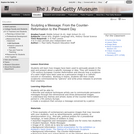
Students will learn how images have been used to persuade people in the past and present about a specific message or idea. They will research the 17th-century European Counter-Reformation and discuss how a sculpture of a saint might have been used as a persuasive image in a Catholic convent or monastery. Working in teams, students will then create sculptures commissioned by "patrons" and write press releases to promote their creations.
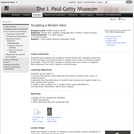
Students will examine the sculpture of the Greek hero Herakles (Hercules to the Romans) and discuss what it means to be a hero in ancient Greece and today. They will then choose a modern hero and create a sculpture that expresses the hero's identity and attributes.
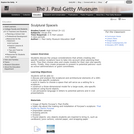
Students discuss the unique considerations that artists creating site-specific outdoor sculpture have to take into account when planning their work. They then choose sites and create models for their own site-specific works. Finally, they create proposals to present to potential patrons - such as school administrators or grant committees.
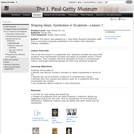
This is the first lesson in a sequential unit. Students consider the ways that sculptors have represented concepts and ideals as symbolic forms in three dimensions. They compare historical examples to those in contemporary culture, and begin sketching designs for their own symbolic sculpture.
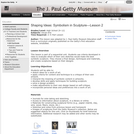
This lesson is part of a sequential unit. Students use criteria developed in class to evaluate which of their own sketches would make the best symbolic sculpture. They choose a final design, techniques and materials, and create sculptures based on their designs.
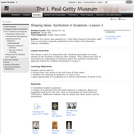
This lesson is part of a sequential unit. Students participate in a class critique of the symbolic sculptures they created. They critique the work of their peers by responding to questions about the symbolic content and applying criteria for sculpture developed in Lesson 1.
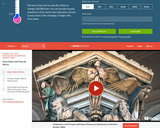
This art history video discussion looks at Claus Sluter's (with Claus de Werve) "The Well of Moses", 1395-1405 (calvary finished 1399, prophets 1402-05, painted by Jean Malouel c. 1402), Asnières stone with gilding and polychromy, slightly less than 7 meters high, originally close to 13 meters with cross. Located on the grounds of the former Chartreuse de Champmol, a Carthusian monastery in Dijon, France established by Philip the Bold, Duke of Burgundy. The prophets depicted include: Moses, David, Jeremiah, Zachariah, Daniel, and Isaiah.
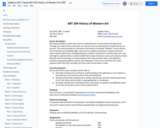
Course syllabus that outlines the first course in a survey of Western Art. Includes an outline of a 10-week course with readings, videos, and other resources.
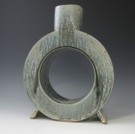
A begging guide for a studio Ceramics course with breakdowns of studio equpment, methods of making, imagry and text breakdowns and demonstrations, and assignments.

Brendan Monroe doesn't follow strict guidelines, especially when it comes to his artwork. He makes rough sketches of his ideas and improvises along the way, making sure to keep the blurriness of the concepts and the mystery. His aim is to encourage people to see living things in everything in their environment.
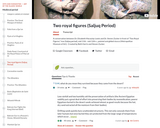
This art history video features a conversation between Dr. Elizabeth Macaulay-Lewis and Dr. Steven Zucker in front of "Two Royal Figures," Iran (Saljuq period), mid 11th - mid 12th c., painted and gilded stucco (Metropolitan Museum of Art).
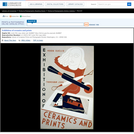
Poster for Federal Art Project exhibition of ceramics and prints at 4300 Euclid, showing a sculpted bust, a print, and tools. Date stamped on verso: Jun 18 1938.
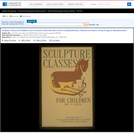
Poster announcing scuplture classes for children conducted by the Art Teaching Division of the WPA Federal Art Project, showing sculpture of a horse. Date stamped on verso: Apr 9 1938.

Poster for Federal Art Project Works Progress Administration exhibition of sculpture at the Federal Art Gallery, 225 West 57 St., New York City, showing Maurice Glickman's "Destitute (Mother and child)." Date stamped on verso: Apr 9 1938. Posters of the WPA / Christopher DeNoon. Los Angeles : Wheatly Press, c1987, no. 65
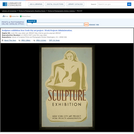
Poster announcing exhibit of sculpture from the New York City Art Project, showing sculpture of a seated woman. Date stamped on verso: Mar 24 1941.
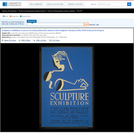
Poster announcing exhibit of sculpture by WPA Federal Art Project artists at the WPA Federal Art Project Gallery, 7 East 38 Street, New York City.